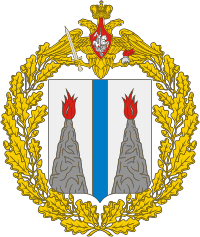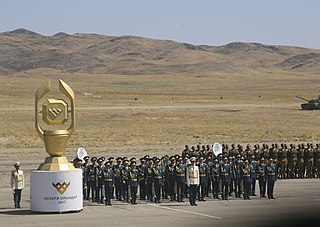
The Western Group of Forces (WGF), previously known as the Group of Soviet Occupation Forces in Germany (GSOFG) and the Group of Soviet Forces in Germany (GSFG), were the troops of the Soviet Army in East Germany. The Group of Soviet Occupation Forces in Germany was formed after the end of World War II in Europe from units of the 1st and 2nd Belorussian Fronts. The group helped suppress the East German uprising of 1953. After the end of occupation functions in 1954 the group was renamed the Group of Soviet Forces in Germany. The group represented Soviet interests in East Germany during the Cold War. Before changes in Soviet foreign policy during the early 1990s, the group shifted to a more offensive role and in 1989 became the Western Group of Forces. Russian forces remained in the eastern part of Germany after the dissolution of the Soviet Union and German reunification until 1994.
A mechanised corps was a Soviet armoured formation used prior to the beginning of World War II and reintroduced during the war, in 1942.

The Order of Lenin Leningrad Military District is a military district of the Armed Forces of the Russian Federation. The district was awarded the Order of Lenin in 1968. In 2010, it was merged with the Moscow Military District, the Northern Fleet and the Baltic Fleet to form the new Western Military District. In December 2022, Defense Minister Sergey Shoigu proposed to reestablish it along with the Moscow Military District, a decision confirmed in June 2023 by Deputy Chief of the General Staff Yevgeny Burdinsky. On December 17, 2023, Russian President Vladimir Putin announced plans to recreate the Leningrad Military District as a reaction to Finland joining NATO. The district was formally reconstituted on 26 February 2024 by a Presidential Decree No.141, transferring the Northern Fleet under its command.

The Red BannerCarpathian Military District was a military district of the Soviet Armed Forces during the Cold War and subsequently of the Armed Forces of Ukraine during the early Post-Soviet period.

The Far Eastern Military District was a military district of the Armed Forces of the Russian Federation. In 2010 it was merged with the Pacific Fleet and part of the Siberian Military District to form the new Eastern Military District.

The 3rd Guards Tank Army was a tank army established by the Soviet Union's Red Army during World War II. The 3rd Tank Army was created in 1942 and fought in the southern areas of the Soviet Union and Poland, then in Germany and Czechoslovakia until the defeat of Germany in 1945. Postwar, the army served as occupation troops in East Germany, went through several name changes, and was finally deactivated in 1969.
The 55th Guards Rifle Division was a Red Army military unit, engaged in the Second World War. Its full name was the 55th Guards Rifle Irkutsk-Pinsk Order of Lenin, Order of the October Revolution, three Red Banner, Order of Suvorov 2nd degree division named after the Supreme Soviet of the RSFSR.
The 36th Army was a military formation of the Red Army and the Soviet Ground Forces, formed twice.
The 40th Guards Rifle Division was one of a series of ten Guards rifle divisions of the Red Army formed from airborne troops in the spring and summer of 1942 in preparation for, or in response to, the German summer offensive. It fought in the Stalingrad area during that battle, eventually in the operations that encircled German 6th Army, and then continued to serve in the several campaigns in the south sector of the front, helping to liberate Ukraine and the Balkans, and ending the war at Vienna.
The 23rd Guards Motor Rifle Division of the Soviet Union's Red Army was a motor rifle division active during the Cold War. After 1991-92, the division's remnants were eventually incorporated into the new Army of Azerbaijan.

The 19th Guards Mechanized Brigade is a formation of the Armed Forces of Belarus based in Zaslonovo, a few kilometers east of Lepiel. The brigade traces its history back to the 1942 formation of the 2nd Guards Mechanized Corps of the Soviet Army during World War II. Subsequent designations during the Cold War included 2nd Guards Mechanized Division and 19th Guards Tank Division. Following the Cold War, the 19th Guards Tank Division was relocated to Belarus and became part of their armed forces in 1992. Thereafter, the unit was reduced to a personnel and equipment cadre unit and titled the 19th Guards Base for Storage of Weapons and Equipment before being upgraded to a mechanized brigade in 2008.

The 9th Guards Dniester-Rymnik Red Banner Order of Kutuzov Motor Rifle Division was a Soviet Army unit initially formed as a tank corps in April 1942. In the same year, it was then formed as a mechanized corps in November 1942. This unit then became a Guards mechanized corps in September 1944. Following World War II, the corps were reorganized as a mechanized division in 1945 and then a motor rifle division in 1957 before being disbanded in 1958.
The 17th Guards Rifle Division was an infantry division of the Red Army during World War II. It was created on March 17, 1942, from the first formation of the 119th Rifle Division, in recognition of that division's stalwart defense against German Army Group Center in the Battle of Moscow, and in the subsequent strategic offensive that threw the German forces back from the capital. It became the 123rd Guards Motor Rifle Division in 1957 and converted into the 129th Guards Machine-Gun Artillery Division in 1989. In 2001, it was converted to the 17th Guards Motor Rifle Division and became the 70th Guards Motor Rifle Brigade in 2009. The brigade was reorganized as the 114th Guards Motor Rifle Regiment of the reformed 127th Motor Rifle Division in 2018. The regiment is currently based in Ussuriysk.
The 89th Motor Rifle Division was a motor rifle division of the Soviet Army, formed twice. The division was first formed in 1957 from the 14th Mechanized Division, which was the former 284th Rifle Division. In 1966, it was reformed as a mobilization division. In 1987, it became a territorial training center and a storage base soon after. It was disbanded in 1996. The unit was based at Tambov.

The Kazakh Ground Forces is the land service branch of the Armed Forces of the Republic of Kazakhstan. It is one of the three uniformed military services, and is the most senior branch of the Kazakh military in order of precedence. The main tasks of the Ground Forces include the following: maintaining the readiness of troops to repel aggression, the armed defense of the territorial integrity and sovereignty of Kazakhstan, protecting the state and military facilities, peacekeeping missions. In its duties, it primarily engages in land warfare and combined arms operations, including armored and mechanized operations as well as airborne and air assault operations. It is headed by a chief military officer, the Commander of the Ground Forces who is also a member of the General Staff.
The 57th Red Banner Ural-Khingan Rifle Division was an infantry division of the Red Army and the Soviet Army.
The 4th Guards Motor Rifle Division was a motorized infantry division of the Soviet Army during the Cold War.
The 47th Guards Nizhnedneprovskaya Red Banner Order of Bogdan Khmelnitsky Tank Division, was a tank division of the Soviet Armed Forces, later Russian Ground Forces.

Otar Military Base is a military installation of the Armed Forces of Kazakhstan located near Otar, in the Zhambyl District, Almaty Region, Kazakhstan.










